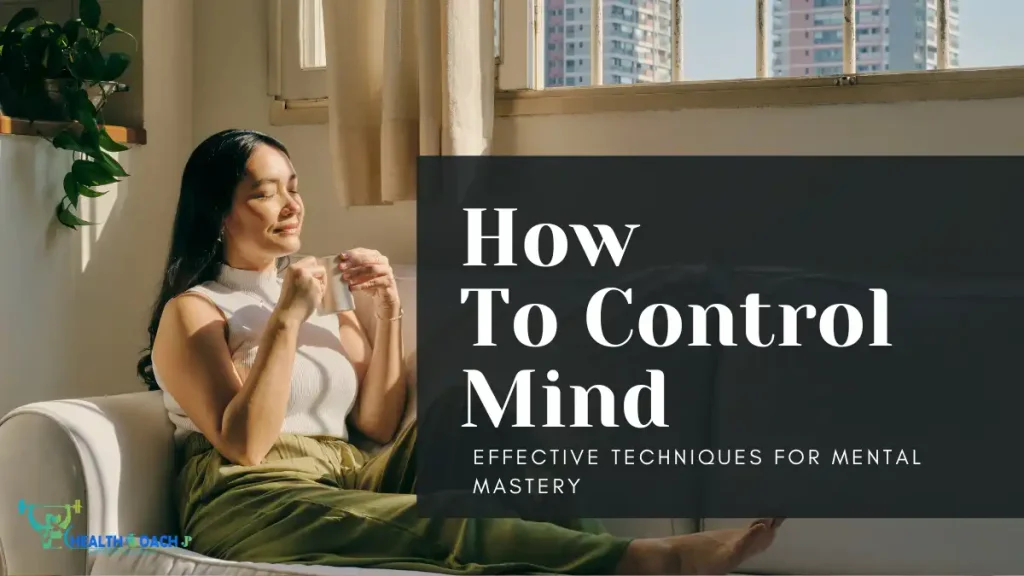The mind is the source of all our thoughts, feelings, and perceptions, influencing every aspect of our lives. Learning how to control your mind is essential to achieving mental clarity, emotional stability, and overall well-being. Uncontrolled thoughts can lead to anxiety, overthinking, and depression, but mastering your mind opens the door to personal success and happiness.

We will explore scientifically-backed techniques and practical strategies for controlling your mind — from understanding the subconscious mind, practicing positive auto-suggestions and visualization, managing emotions, to overcoming negative thoughts. By the end, you’ll gain actionable insights to help you take charge of your mental landscape.
Understanding the Mind and Its Power
What Is the Mind?
Your mind is the center of consciousness, responsible for generating thoughts and feelings. It constantly interprets stimuli, shaping your experiences of reality. The mind works on two primary levels:
- Conscious mind: Thinks logically and can accept or reject ideas.
- Subconscious mind: Powerful and automatic, it agrees with all input indiscriminately and stores memories, habits, and beliefs.
The subconscious mind functions like a vast data bank and controls much of your behavior without your awareness.
Why Controlling the Mind Matters
An uncontrolled mind leads to racing thoughts, negative self-talk, stress, and emotional turmoil. Conversely, a controlled mind allows you to:
- React calmly to challenges.
- Maintain focus and motivation.
- Cultivate emotional resilience.
- Improve decision-making.
- Experience inner peace.
Controlling your mind means guiding your thoughts and emotions rather than letting them rule you.
How to Control Your Subconscious Mind
The Subconscious Mind’s Role
Your subconscious mind is incredibly influential but does not differentiate between positive and negative information. Whatever you feed it—whether worries or affirmations—it absorbs, often shaping your reality through repeated beliefs.
Reprogramming the Subconscious Mind
Since the subconscious drives habits and attitudes, programming it with positive thoughts is foundational to mental mastery. Here are two essential techniques:
1. Positive Auto-suggestion
Auto-suggestions are positive affirmations you repeat to yourself in the present tense to influence your beliefs and habits. For example:
- “I am calm and focused.”
- “I am confident and in control.”
By consistently repeating these statements, they sink into your subconscious and reshape your mindset and behavior.
Important Tips:
- Use present tense, positive language.
- Make affirmations short and specific.
- Repeat multiple times daily, especially in relaxed states.
2. Visualization
Visualizing involves creating vivid mental images of your desired outcomes, accompanied by positive emotions. This helps deepen the influence of auto-suggestions.
How to Visualize Effectively:
- Imagine yourself succeeding in detail — the sights, sounds, feelings.
- Use emotions to amplify the experience.
- Practice daily, especially before sleep or during meditation.
Combining positive auto-suggestions with visualization maximizes subconscious reprogramming and confidence.
How Thoughts Affect Yourself and Others
Thoughts emit energy vibrations that influence you and your surroundings. Negative thoughts deepen negativity in you and others, while positive thoughts foster growth and harmony.
Key insight:
Focus on positive qualities in people and situations to radiate uplifting vibrations that reinforce good outcomes. This mindset shift improves relationships and enhances your inner peace.
Emotional Control: Your Key to Mental Mastery
What Are Emotions?
Emotions are responses generated by your thoughts, beliefs, and perceptions. While you can’t always control external events or other people’s actions, you fully control your reactions.
How to Control Emotions
- Recognize emotions as temporarily arising from your thoughts.
- Choose your responses consciously, rather than reacting impulsively.
- Accept responsibility for how you feel — no one can “make” you feel a certain way without your permission.
- Cultivate emotional maturity by practicing self-awareness and patience.

Practical Tips for Emotional Control
- Pause before reacting.
- Use deep breathing or mindfulness.
- Replace negative self-talk with calm, positive affirmations.
- Engage in activities that uplift your mood.
Managing and Overcoming Negative Thoughts
Negative thoughts can become a toxic loop that drains your energy and focus. Here’s how to take control:

Step 1: Identify Negative Thoughts
- Pay attention to recurring worries or doubts.
- Journal your thoughts to increase awareness.
- Catch negative thoughts early to prevent escalation.
Step 2: Challenge and Replace Negativity
- Counter each negative thought with a positive, realistic statement.
- For example, change “I always fail” to “I am learning and improving every day.”
Step 3: Practice Optimism and Gratitude
- Start each day by listing things you are thankful for.
- Focus on simple pleasures — the smell of coffee, a pleasant sound.
- This reframes your mindset away from negativity.
Step 4: Maintain Healthy Habits
- Eat nutritious food.
- Exercise regularly.
- Get enough sleep.
- Avoid substances that impair mental health, such as excessive alcohol or smoking.
Step 5: Practice Meditation and Mindfulness
- Use mindful breathing to stay present and reduce mental clutter.
- Recite positive affirmations aloud.
- Visualize your goals and strengths.
Regular practice strengthens your ability to control thoughts and keep negativity at bay.
Additional Techniques for Mind Control

- Mindfulness Meditation: Train your mind to observe thoughts without attachment.
- Cognitive Behavioral Techniques: Reframe negative thinking patterns logically.
- Focus Exercises: Practice sustained attention on one task to improve mental discipline.
- Journaling: Express emotions and track progress.
- Healthy Social Connections: Surround yourself with supportive influences.
Frequently Asked Questions (FAQ)
Yes. With consistent practice and the right techniques, anyone can improve control over their mind.
Results vary, but positive changes typically emerge within a few weeks of regular practice.
It’s normal to face challenges. Persistence with journaling, affirmations, and support will help.
Conclusion
Mastering how to control your mind is a lifelong journey, but the rewards are profound. By understanding the subconscious, embracing positive auto-suggestions and visualization, managing your emotions effectively, and overcoming negative thoughts, you can transform your mental landscape.
Start with small daily steps — positive affirmations, gratitude journaling, mindful breathing — and build momentum. With patience and practice, you’ll unlock greater mental clarity, emotional balance, and a happier, more successful life.
Take control today, and let your transformed mind lead the way to your best self.
References-
- National Institute of Mental Health (NIMH)
- When referencing mental wellness, evidence-based advice, or common mental health challenges, link to NIMH for factual and trustworthy information.
- Stanford Encyclopedia of Philosophy: Mental Disorder
- Use this source when discussing philosophical perspectives on the mind, cognitive functions, or the definition of mental health.
- American Psychiatric Association: Understanding DSM-5
- Mindful.org or The Top 5 Websites for Exploring and Practicing Mindfulness
- Insight Timer: Subconscious Mind Exploration Meditations
- UCLA Mindful Awareness Research Center
- Public Health England: Mental Health and Wellbeing
- Works well when supporting claims about environmental factors and community resources for mental health.
